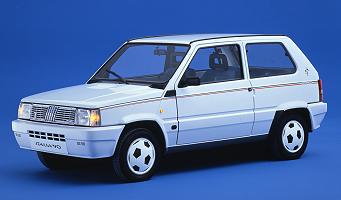The two original engines were added to in September 1982 when the Panda 34 was revealed, this using an 843cc water-cooled unit
derived from that in the 850.
At the Paris Motorshow later in 1982 the Panda 45 Super was revealed. This had numerous improvements, most significant being the
availability of a five speed gearbox as well as trim and minor styling changes. The new black plastic 'corporate' grille (actually
the first production use of this grille with the five diagonal silver bars) distinguished it from the earlier models with the
'metal with slots' grilles. A 30 Super was added to the range in February 1983.
Meeting with great success, the 1,000,000th Panda produced in July 1984, by the end of 1985 1,400,000 Panda (of all versions) had been built.
Minor revisions in November 1984 saw the range renamed “L”, “CL” and “S” together with some detail modifications including the
adoption of the new corporate grille, with the five diagonal bars, by all the versions.
April of that same year saw the introduction of a 1301cc diesel engine with 37bhp (a detuned 127/Uno unit). Fitted as standard with a
five speed gearbox it was only available in the basic ‘L’ trim. The van version of the Panda was also introduced in the same month,
with both petrol and diesel engines. This had the rear windows blanked off and a small (always black) plastic extension attached to the rear
The following year, 1987, saw the arrival of the Panda Young with a 769cc ohv engine which used the old 903cc block and produced the
same 34bhp as the FIRE unit. The 999cc FIRE also got single-point fuel injection and a catalytic converter in that year, and the Panda
4x4 Sisley limited edition was released.
The two-seat Panda Elettra, introduced in 1990, was an early player in the environmentally-friendly electric car stakes. The batteries
occupied all the space behind the front seats plus some under the bonnet where the 18bhp DC motor was also fitted, driving through the
normal clutch and gearbox. The weight increased significantly, to 1150kg, necessitating stiffer suspension and uprated brakes. In 1992
the power went up to 23.8bhp and the weight dropped slightly.
The next major facelift came in 1991 with a redesign (most visibly a new front grille) and revision of the range.
New arrivals included the ‘Selecta’, which had an electronic CVT (electromagnetic clutch plus CVT transmission). This advanced
transmission was available either with the normal 999cc FIRE engine, but also an all new 1108cc FIRE unit, fitted with electronic
fuel injection and a three-way catalytic converter and producing 51bhp. The new CLX trim also featured a five-speed gearbox as standard.
The range now comprised the 750 Young (769cc ohv), 750 and 750 CLX (both 769cc FIRE sohc), 900 Dance (903cc ohv), 1000 Shopping,
In the next year, the 1108cc engine, complete with SPI and catalyst, replaced the 1000 unit in the 4x4 (with 50bhp) and also in 1992
an 899cc (with injection and catalyst) became available, in the 'Cafe' special edition. This was a reduced capacity 903cc unit,
designed to meet tax requirements in some markets.
1994 was the next date for a revision to the venerable Panda. Due to legal requirements for a catalytic converter, the 769cc
engine was discontinued, all the versions with the 903cc unit got the reduced 899cc (with 39bhp) and both that unit and the 1108cc
unit were fitted with injection and a catalyst across the range. The 999cc Selecta was dropped, whilst another 4x4 special edition,
the Country Club replaced the old Sisley. The engine in the 4x4 gained 4bhp (taking it to 54bhp) in the following year.
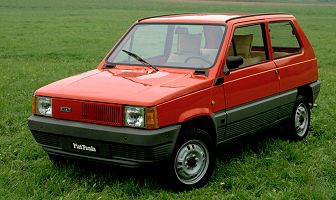 In February 1980 FIAT presented a new 'utility' car, designed by Giugiaro and named the Panda. Fitted with either a two cylinder air-cooled
652cc engine (derived from that in the 126) - the Panda 30, or a four cylinder water cooled engine displacing 903cc
(from the 127) - the
Panda 45, it was conceived and built to be economical to buy and to run, with practicality high on the list of priorities. Designed to
fit between the 126 and 127 in terms of product, it featured several innovative
items such as the 7-position adjustable rear seat, removable
and washable seat covers, door trims and dashboard cover and the fact that all the glass surfaces were flat.
In February 1980 FIAT presented a new 'utility' car, designed by Giugiaro and named the Panda. Fitted with either a two cylinder air-cooled
652cc engine (derived from that in the 126) - the Panda 30, or a four cylinder water cooled engine displacing 903cc
(from the 127) - the
Panda 45, it was conceived and built to be economical to buy and to run, with practicality high on the list of priorities. Designed to
fit between the 126 and 127 in terms of product, it featured several innovative
items such as the 7-position adjustable rear seat, removable
and washable seat covers, door trims and dashboard cover and the fact that all the glass surfaces were flat.
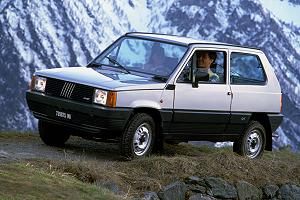 The Austrian company, Steyr-Puch, developed a four wheel drive system for the next addition to the range, the Panda 4x4. Launched in
June 1983, it was powered by a 965cc engine with 48bhp derived from that in the Autobianchi A112. Known simply as the Panda 4x4, this
model was the first small, transverse-engined production car to have a 4WD system. The system itself was manually selectable, with an
ultra-low first gear. Under normal conditions starting was from second, with the fifth having the same ratio as fourth in the normal
Panda. Steyr-Puch supplied the entire drivetrain (clutch, gearbox, power take-off, three-piece propshaft, rear axle inc diff and brakes)
to the plant at Termini Imerese where it was fitted to the reinforced bodyshell. With a weight of 740kg it completed the standing km in
38.8 seconds and went on to a top speed of 84mph.
The Austrian company, Steyr-Puch, developed a four wheel drive system for the next addition to the range, the Panda 4x4. Launched in
June 1983, it was powered by a 965cc engine with 48bhp derived from that in the Autobianchi A112. Known simply as the Panda 4x4, this
model was the first small, transverse-engined production car to have a 4WD system. The system itself was manually selectable, with an
ultra-low first gear. Under normal conditions starting was from second, with the fifth having the same ratio as fourth in the normal
Panda. Steyr-Puch supplied the entire drivetrain (clutch, gearbox, power take-off, three-piece propshaft, rear axle inc diff and brakes)
to the plant at Termini Imerese where it was fitted to the reinforced bodyshell. With a weight of 740kg it completed the standing km in
38.8 seconds and went on to a top speed of 84mph.
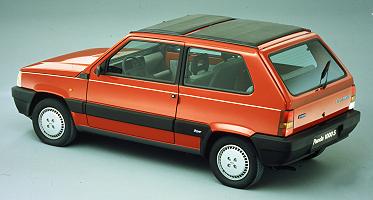 Major changes to the Panda arrived in January 1986. The 650cc engine was replaced by a 769cc (34bhp) unit, and the 903cc by a 999cc
(45bhp or 50bhp in the 4x4) item. Both the new engines were from the new FIRE family of 4 cylinder water-cooled powerplants with a
single overhead camshaft.
Out with the old was the message for the rear suspension too, with the rear leaf springs being replaced by an independent system
using a rigid rear axle (known as the 'Omega' axle) with a central mounting and coil springs (the 4x4 continued to use two longitudinal
leaf springs). Improvements were also made to the interior and the structure, which was strengthened. The full range became 750L,
750CL, 750S, 1000S and 4x4.
Major changes to the Panda arrived in January 1986. The 650cc engine was replaced by a 769cc (34bhp) unit, and the 903cc by a 999cc
(45bhp or 50bhp in the 4x4) item. Both the new engines were from the new FIRE family of 4 cylinder water-cooled powerplants with a
single overhead camshaft.
Out with the old was the message for the rear suspension too, with the rear leaf springs being replaced by an independent system
using a rigid rear axle (known as the 'Omega' axle) with a central mounting and coil springs (the 4x4 continued to use two longitudinal
leaf springs). Improvements were also made to the interior and the structure, which was strengthened. The full range became 750L,
750CL, 750S, 1000S and 4x4.
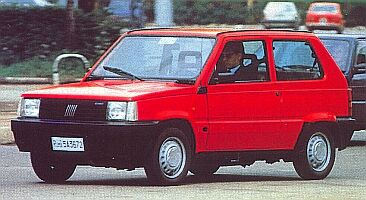 In August 1988 the 2,000,000th Panda came off the production line and in the following year the pushrod 903cc engine was re-introduced
for export and some limited editions.
In August 1988 the 2,000,000th Panda came off the production line and in the following year the pushrod 903cc engine was re-introduced
for export and some limited editions.
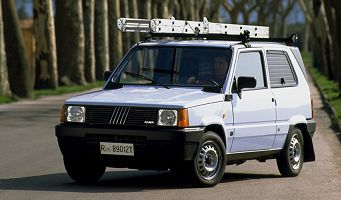 CLX, CL Selecta and S (all with 999cc sohc, available with or without SPI and catalytic converter), 1100 CL Selecta (1108cc sohc
with SPI and cat) and the 4x4 Trekking (999cc available both with and without a cat). The Elettra finished off the offer.
CLX, CL Selecta and S (all with 999cc sohc, available with or without SPI and catalytic converter), 1100 CL Selecta (1108cc sohc
with SPI and cat) and the 4x4 Trekking (999cc available both with and without a cat). The Elettra finished off the offer.
Technical Details
| Driveline | longitudinal engine at front with front wheel drive or 4 wheel drive |
| Engines |
652cc (77x70mm) two cylinder ohv air cooled with 30bhp @ 5,500rpm (126 derived)
843cc (65x63.5mm) four cylinder ohv with 34bhp @ 5,800rpm (850 derived) 903cc (65x68mm) four cylinder ohv with 45bhp @ 5,600rpm (127 derived) 965cc (67.2x68mm) four cylinder ohv with 48bhp @ 5,600rpm (A112 derived) 769cc (65x58mm) four cylinder sohc with 34bhp @ 5,250rpm (FIRE) 769cc (65x58mm) four cylinder ohv with 34bhp @ 5,250rpm (903 engine derivative) 999cc (70x64.9mm) four cylinder sohc with 45bhp @ 5,000rpm (FIRE) (50bhp in the 4x4) 1108cc (70x72mm) four cylinder sohc with 50bhp @ 5,250rpm (FIRE) (later with 54bhp in some versions) 899cc (65x67.7mm) four cylinder ohv with 39bhp @ 5,500rpm (903 engine derivative) 1301cc (76.1x71.5mm) four cylinder sohc diesel with 37bhp @ 4,000rpm (Uno/127 derived) |
| Suspension | front : MacPherson strut with telescopic dampers and coil springs plus anti-roll bar
rear : (early) tubular axle with telescopic dampers and leaf springs rear : (late) independent system with 'Omega' axle and coil springs wheelbase : 2160mm front track : 1254mm rear track : 1249mm (4x4 : 1258mm) |
| Brakes | front : discs, diameter 227mm
rear : drums, diameter 185mm calliper piston diameter : 48mm (front) cylinder bore diameter : 15.875mm (rear) handbrake operating on the rear via cable dual hydraulic circuit |
| Gearbox | 4 and 5 speed manual
electronic CVT rod linkage cable operated clutch disc diameter : 170mm |
| Steering | Rack and pinion
3.4 turns lock to lock |
| Kerb weight | '45' : 680kg
4x4 : 740kg |
| Dimensions | Panda 1000S and Panda 4x4. |
click here for a cutaway view of a Panda 45
Performance
| model | max speed | standing km | 0-100 km/h | Braking (from 120km/h) |
| Panda 45 (1982) | 138 km/h | 37.4 km/h | 14.7 sec | 64.8 m |
| Panda 30 (1982) | 118 km/h | 43.3 km/h | 28.1 sec | 51.4 m |
Tuning
There are three main areas to concentrate
on, the engine (and transmission), the brakes and the suspension and then
various other details. These three should be done together since they complement
each other, not all of one and none of another !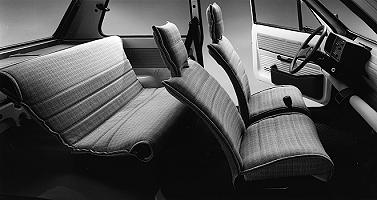 The Panda may not seem the most obvious
choice of car to be tuned, but there are some modifications which will
make it go, handle and stop better - thus increasing the safety whilst
decreasing the time taken of journeys.
The Panda may not seem the most obvious
choice of car to be tuned, but there are some modifications which will
make it go, handle and stop better - thus increasing the safety whilst
decreasing the time taken of journeys.
1. The engine.
Before modifying the engine it is worthwhile filling it with a good quality synthetic oil and fitting new spark plugs. An engine oil additive may also be used.
The first improvements are relatively simple.
The air filter can be replaced for an aftermarket item which will help
the engine breathe The main modification (outside of taking
the engine apart) is to fit a better carburettor. A camshaft will also
provide a noticeable gain, especially if fitted in conjuction with the
carburettor.
Other things to do should include fitting
a cold air intake, a large diameter pipe (minimum 5cm) to provide air from
outside the engine bay to the air filter. The exhaust manifold can also
be lagged with thermal cloth or tape to keep the exhaust gases hotter (and
thus reduce back pressure) and also to keep the underbonnet (and hence
intake and fuel) temperatures lower.
Further modifications require the machining
of the cylinder headand/or cylinder block (which will not be dealt with
here since it is not normally a DIY job) after which it may be worth fitting
an oil cooler. If overheating is a problem due to the increased power output
then a small hole can also be drilled through the plate in the thermostat.
Regarding the transmission the main requirement
is to uprate the clutch to handle the increase in power and torque achieved
though the engine modifications. Friction plates can be purchased with
improved materials and heavier duty pressure plates are also available.
Whilst doing this it is worthwhile lightening the flywheel.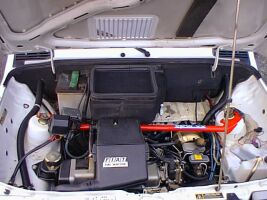 more
freely and the exhaust can be replaced for one which will restrict the
exit of the gases less.
more
freely and the exhaust can be replaced for one which will restrict the
exit of the gases less.
The high tension leads can also be replaced
with performance ones.
2. The brakes.
If more serious braking is required the
next modification would be to increase the disc size. It is possible to
use larger discs with a bracket allowing use of the production callipers,
or alloy four pot callipers can be fitted but the weight of the Panda is
unlikely to ever justify this.
In order to improve the balance of the
car under braking it is desireable to be able to adjust the balance of
braking from front to rear (and vice versa). This can be accomplished by
fitting a bias valve in the line to the rear brakes, usually in a position
so that it can be reached from the drivers seat.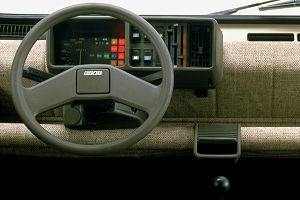 Initially it is relatively easy to replace
the brake discs with drilled and grooved items, and the pads for a harder
compound. The latter should not be too hard (ie no race pads on the road)
or they will not function effectively at the normal 'road' operating temperatures.
Stainless steel braided flexible hoses will improve the pedal feel and
reduce the chance of damage whilst DoT5 fluid (not silicon) will increase
the temperature at which it can operate effectively. If the brakes are
getting too hot the dustguards can be removed and/or ducts fitted, taking
air from behind the front bumper.
Initially it is relatively easy to replace
the brake discs with drilled and grooved items, and the pads for a harder
compound. The latter should not be too hard (ie no race pads on the road)
or they will not function effectively at the normal 'road' operating temperatures.
Stainless steel braided flexible hoses will improve the pedal feel and
reduce the chance of damage whilst DoT5 fluid (not silicon) will increase
the temperature at which it can operate effectively. If the brakes are
getting too hot the dustguards can be removed and/or ducts fitted, taking
air from behind the front bumper.
3. The suspension.
The easiest improvement,and the one which
will probably bring the single most noticeable change, is to replace the
dampers and springs. At the front, everything can be replaced, at the rear
the suspension can be lowered by clamping the leaf springs. Top adjustable
dampers are compromised, but are good for road and track day cars since
it allows the suspension to be adjusted between these two, rather different,
There are then two other main suspension
aims; to reduce the flexiblity in the suspension and to increase the stiffness
of the car, both
of which aim at more accurate control of the wheel movement. To reduce
the flexibility it is possible to fit nylon bushes instead of the normal
production rubber items, or if perfection is desired the suspension can
be fitted with metallic bearings (rose joints / rod ends). Spherical bearing
top mounts can also be used. To stiffen the car it is most popular to fit
strut braces. These can be fitted to the front and rear. For more extreme
cases a rollcage can be fitted.....
Into this category also fall the choice
of wheels and tyres. With an increase in power it can be necessary to fit
larger tyres (thus requiring larger wheels) but the temptation to fit the
biggest possible should be resisted. Consideration should be given to fitting
a wider tyre on the front (since they provide traction and steering) but
keeping the standard, or a wider but not as wide as the front, tyre at
the rear. This will improve the balance of the car.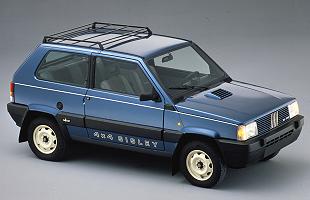 requirements. Coil over units add more adjustability and can be purchased
outright, or can be made from standard dampers by welding a threaded sleeve
to the standard tube.
requirements. Coil over units add more adjustability and can be purchased
outright, or can be made from standard dampers by welding a threaded sleeve
to the standard tube.
4. other things.
Other modifications worth considering include
fitment of a shift light (and rev limiter if there is not one as standard),
higher power bulbs in the headlights (if you are going to go faster you
need to see further) and installation of a quicker steering rack.
Haynes produce a good quality workshop
manual for the Panda - buy it at our online bookshop
(in association with Amazon).
Maintenance
The following data refers to the 1991 Panda :
Scheduled maintenance :
Replace air filter : every 20 000km
recommended engine oil : SAE 15W/40 semisynthetic multigrade oil exceeding API-SG and CCMC-G4 specifications.
tyre inflation pressures (front/rear) : 2.0bar / 2.0 bar (for fully laden 2WD car use 2.2bar / 2.2bar)
Check valve clearances : 20 000km, 60 000km and then every 40 000km
Check points gap : every 20 000km (for Marelli distributor reuired gap is 0.42mm to 0.48mm)
Replace spark plugs : every 20 000km (required gap is 0.7mm to 0.8mm)
Replace fuel filter (petrol & diesel) : every 20 000km
Replace timing belt (FIRE & diesel) : every 100 000km
Engine oil change : every 20 000km or 12 months (diesel : every 7 500km or 12 months)
recommended transmission oil : SAE 80W/90 non-EP
Desktop wallpapers
Click on the correct screen resolution for you computer and the picture will open in the window. You can then
right click and set as desktop.
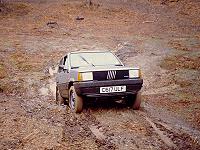
1024x768 pixels |
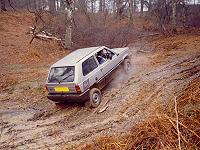
1024x768 pixels |
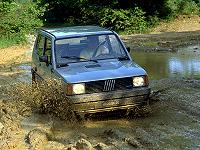
1024x768 pixels |
Maintenance
The Panda is a relatively basic car, and
as such is relatively uncomplicated with little to go wrong.
If you have just purchased a second hand
car there are several components which are worthwhile changing - especially
if it is (as As with any older second hand car the following
should be changed for increased reliability, safety and general health :
It is worth taking a bit of time after
purchase to check the car well - it may save much annoyance later !
It is recommended to jack up each corner
of the car in turn and check the wheel bearings, brake discs/drums, brake
pads/shoes, flexible brake hoses, rubber suspension bushes and driveshaft
CV joint gaiters.
Under the bonnet check the HT leads, distributor
cap and rotor arm, engine earth lead, battery leads and the condition of
Unless a history is provided, it is recommended
to replace the timing belt and alternator/water pump belt since these items
can fail and if they do the car will go nowhere ! Always use manufacturers
belts, NOT aftermarket ones !
Other things to check (to prevent any unpleasant
surprises when going somewhere) are exhaust mounting rubbers, the operation
of all lights (don't forget to try the indicators with the sidelights on
- they sometimes all blink together!) and the correct operation of the
radiator cooling fan.
Haynes produce a good quality workshop
manual for the Panda - buy it at our online bookshop
(in association with Amazon).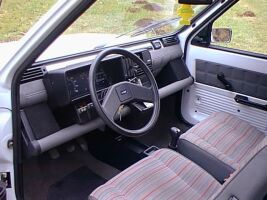 usual)
a high mileage car with no known history.
usual)
a high mileage car with no known history.
Spark Plugs, oil, oil filter, air filter,
brake fluid, windscreen wiper blade(s).
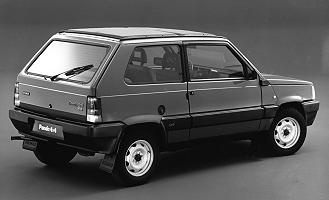 the fuel hoses. With older cars it is always worthwhile buying a can of
fuel system cleaner and pouring it into the tank (or spraying it into the
carburettor) - the internals of engines can easily clog up depending on
prior useage. Slick 50 or a similar substance is also recommended for both
increasing the (remaining) engine life and also reducing the noise, especially
at tickover. Whilst there, the cooling system should be drained, generously
flushed (chemicals can be purchased to assist this) and refilled with the
required anti-freeze added.
the fuel hoses. With older cars it is always worthwhile buying a can of
fuel system cleaner and pouring it into the tank (or spraying it into the
carburettor) - the internals of engines can easily clog up depending on
prior useage. Slick 50 or a similar substance is also recommended for both
increasing the (remaining) engine life and also reducing the noise, especially
at tickover. Whilst there, the cooling system should be drained, generously
flushed (chemicals can be purchased to assist this) and refilled with the
required anti-freeze added.
Buying / Selling
Panda's are now quite(!) cheap, so it is an easy way to buy a good runaround. The best approach with such older, but not collectors, cars is often to buy cheap a runner, then spend a bit of money on it to improve it - see the maintenance section above.
Some tips to do before selling :
(they may seem obvious, but most people don't do them and thus are in a
weaker bargaining position).
Tidy inside the car thoroughly : hoover
the floor, empty all pockets, ashtrays (wash), glove compartment etc...,
wipe the trim with a damp cloth, give the cockpit a good airing to get
rid of any odours ! Reset the trip meter to 00000 - it is a pleasant (subconcious)
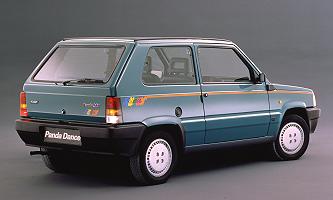 surprise.
surprise.
If the car has been standing give it a
good run - this will clear out the engine (reduce exhaust smoke), put a
shine on the brake discs and loosen up any joints that may otherwise make some noises.
'Back to black' products are very effective
at temporarily restoring bumpers and trim. This makes a big difference
to any car. Do it a week before you expect people to view the car, otherwise
it may be a bit too obvious !
Jetwash under the car, especially under
the engine and in the wheelarches. The prospective buyer may be an enthusiast,
and this makes it easier for them to see what they want to check.
Obviously wash the car and clean the windows !
If you are going to buy a car always
check the following :
Firstly check the bodywork. Pay special
attention to the wheelarches (inside if there is no plastic splash guard),
suspension and engine mounts, sill, door pillars (check for sagging doors),
scuttle panel and the floor (doors, bonnet and boot/hatch are also susceptible,
but are more easily replaced). If a sunroof is fitted check around the
edge for signs of rust. Check that there are no mismatching panels, large
areas of discolouration or signs of fresh paint.
Check for a damp carpet or the presence
of mould - if the carpet is damp then the floor is almost certainly corroded.
Check the main electrical functions - wipers,
lights, etc... try putting the main beam and wipers on at the same time.
Check the headlight reflectors for rust.
The engine should be run up to temperature,
check the exhaust for smoke, the condition of the breather (look for mayonaise),
the condition of the oil filler cap (again white deposits in a Panda probably
indicate a life of short journeys where the engine has never got really
hot and which results in accelerated wear) and the colour of the coolant
(preferably not brown!). Listen to the noise of the engine, then depress
the clutch and engage first gear. Whatever noise has disappeared was coming
form the gearbox, what remains is from the engine. Check the colour of
the oil using the dipstick, a golden-brown is best, dark is ok, but avoid
engines with thick black oil.
Check tyre wear, uneven patterns could imply a bent chassis.
Always take it for a test drive. Check
that the car tracks in a straight line with no steering input. Find a large
open area and complete several lock to lock turns (also in reverse), listening
for any noises. Try the handbrake when moving - seized rear callipers will
mean uneven braking or no braking.
Generally, the Panda is mechanically pretty
good, but until the mid 1980's the bodywork was weak.
Fiat Panda Workshop Manual :
buy it online here (in association with
Amazon)
For more books on Fiats, see our Online Bookstore
There is also a list of all our picture galleries (including museums,
motorshows and various events).
Wallpapers/Desktop Backgrounds of numerous Fiats also available to download.
Screensavers of Fiats, including the Panda, available to download (free).
Links
A personal Fiat Panda website
Your Comments
Just want to say what a great
little car the Panda is. Mine is called peggy, she's a 1985 45 Super, I'm
only her second owner and she's only done 34,000 miles. 15,000 put on by
me with no trouble at all. Anyone else feel the same about Panda's ?
I just bought a Panda recently.
It,s from '91 and it cost about $ 1000. The only improvement I made was
install a c.d. player and two loudspeakers in the back. The previous owner
had speakers up front but that takes up too much space. Apart from some
noises here and there on a bumpy road I'm very satisfied with it.
I've recently bought a 10
year old Panda dance. In 16 years of driving it is the most fun car I've
had. (I also own an 18 month old Fiat Punto). The Panda is so cheap, economical,
nippy, and can be parked anywhere. Mine has 55,000 genuine miles on the
clock, 10 months m.o.t, & cost me £150. Reliable, fun motoring
at a very cheap price. I'd recommend a Panda to anyone.
I Live in Rome Italy and
own A Panda 750. I love it. I modified it a bit and damn it rocks. Expecially
on dirt roads it makes my friends punto eat the dust.
I drove a Panda for the first
time this week, a 750 model, it was great, I understand why Fiat is still
making this car after 20 years, it is just too good!!! (Patrizio, Italy)
I bought a Panda 900 in 1997
for replacing my wife's Uno and I'm fully satisfied with it. Sometimes
I enjoy more driving the Panda rather than my comfortable Brava; Panda
is a myth and I'm glad to own one! (Riccardo, Italy)
Just bought a brand new Panda "Young" 1,1l yesterday for the incredible sales-price of 4.950 ? here in Germany.
Yes, they still make them and they are even more fun to drive with the modern Seicento-engine. I feel that I am driving a living legend here.
The car blends in perfectly with all the other cars on the curbside, yet the Giurgario-drawn lines are not taunted, even after 21 years of production-time. (Stefan T, Germany)
We have just bought a panda sisley 4x4(1990) we paid £350 for it and we are very happy, A great little car!
My Panda is a '92 1000 CLX with almost 100000km on the clock..But it runs like a new car. It´s top speed is 150 km/h!!!!! I´m very happy with it.(Erickson, Portugal)
I bought a 1986 Panda 1000CL with 80245miles for £100 in February 01. Now in Aug 01, I have put 11000 miles on it and I have only had to spend a further £125. It rattles, and the electrics are a bit unreliable, but it is a useful and reliable car - I love it!! (Aidan, UK)
This year we put together a Panda from four 88 pandas, meaning now I have a metallic red Cl super solar (quite a mouthfull)....with some bits from a four wheel drive.
It only cost about £200Uk in all but its great, its very quick for a 1000 engine, and is way faster than my friend's 1.1 ford fiesta. I can get about
90mph and a 0-60 of a little under 14 seconds. I also find it has very predictable handling. A gas-flowed and skimmed head is going on it
soon, so that should make it even swifter. (John)
I have owned 10 different Pandas since 1983. They have all been hassle free and I would recommend them to anyone. They are an excellent all round car.
I make regular runs to Europe with my whole family loaded inside and they don't find it uncomfortable. (Andy, UK)
Owned my Pada Selectra (Yep an Auto) exactly three years. In that time I've covered 52,000 miles, its a 95 model (last of in UK) which now has 98000+ miles
on the clock. Only failed once at 68000 miles when the head gasket went. No other problems, cheap to run/insure and though parts could be cheaper ~£200 in parts a year
for 20,000 miles motoring is hard to beat. (Calum, UK)
I have a Panda 1000s Fire and a Ford Fiesta Sport 1.4. The new and pretty Fiesta reaches 190 km/h but it drinks gasoline like mad.
The panda reaches easily 150 kmh and the compsumption remains very very very (and i mean very) low. Im from spain and the speed limit is 120 km/h.
When i get the drive permission i was dissaponited of having to drive that car, but soon i was amazed with the performance of this ugly and squared thing.
When my friends looked at it for first time some of them compared it to a 50cc vespino, six months later they remain quiet when i say "follow me if you can",
and they have an opel corsa, a rover200 and a peugeot 205.
They can get me only in a highway, but police can get them too !
What i can said! , the Panda is cheap to maintain, fast and maneuverable, and u can drive 200 kms at 120 km/h with the engine at 60º, if someday fiat makes a
revision of the panda with a little cuter design, it will be the car of my dreams.
I have owned Pandas and currently run a 1986 4x4 and a 1994 automatic. Plus I have a 750 Cabriolet to restore. I intend to go straight to Turin and buy
one straight from the factory when my lottery number comes up. (Andy, UK)
I had an absolutely immaculate 1989 1000Super for around a year, but it came to the point where I had to move on to
something larger. BUT I have now found myself with another one, a 1988 1000CL, only this time as a second car, I just couldn't resist buying
another, paying just £200, with 74k on the clock, what a bargain!! I have recently fitted a bolt on air filter, a modified exhaust and some Uno
Turbo alloys. Its now a right head turner, whether its just people turning their heads to laugh I dont know, but I love it, A perfect car to have a laugh with!! (Dave, UK)
I persuaded both of my daughters to have Pandas as first cars, the latest a 1000 Super, initially for the fact that they have a low insurance group for young drivers.
Although I normally drive more modern cars, I have grown to love Pandas and have had a great deal of pleasure in ocassionally driving them. You can read the reports
that say how basic they are and how it is the next best thing to catching a bus but I think that it is great fun to drive, and it does need to be driven! It is quite nippy and can
hold its own on the open road reasonably well with much flashier cars.
Use
the buttons at the top to navigate further, or
Copyright © 2000 to 2008 CarsfromItaly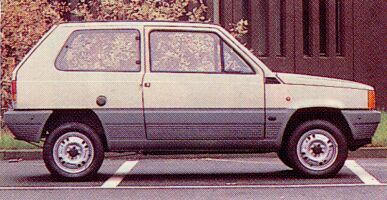 Check
the brake pedal does not go to the floor if pressed hard for a long time
and check the gearchange for clean engagement.
Check
the brake pedal does not go to the floor if pressed hard for a long time
and check the gearchange for clean engagement.
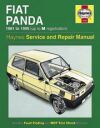 Fiat
Panda ('81 to '95)
Fiat
Panda ('81 to '95)Haynes
Fiat
Panda : Repair Manual & Service Guide
Porter
Panda comment form
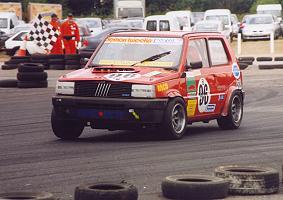 I have 2 Pandas, a twin-sunroof
1987 1000S and a 1995 1000CLX. I'd recommend them to anybody as a low-budget
fun car, easy to maintain, surprisingly good handling (on 155 section tyres
- 135's are a bit TOO narrow!), and very cheap to run. Watch out for split
inboard driveshaft gaiters, though - they're death to gearboxes when the
oil escapes. Much prefer the later car's servo brakes, as the pedal effort
required is more consistent with the car's other controls. (Chris, UK)
I have 2 Pandas, a twin-sunroof
1987 1000S and a 1995 1000CLX. I'd recommend them to anybody as a low-budget
fun car, easy to maintain, surprisingly good handling (on 155 section tyres
- 135's are a bit TOO narrow!), and very cheap to run. Watch out for split
inboard driveshaft gaiters, though - they're death to gearboxes when the
oil escapes. Much prefer the later car's servo brakes, as the pedal effort
required is more consistent with the car's other controls. (Chris, UK)
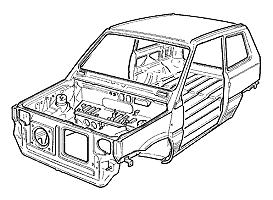 I've had all kinds of cars,but the panda is the best value for money,it is very underated,I like my panda but I am planing to get a 4x4 panda in the future!
I've had all kinds of cars,but the panda is the best value for money,it is very underated,I like my panda but I am planing to get a 4x4 panda in the future!
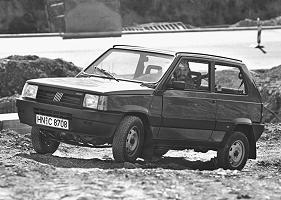 I bought a Panda Dance for £300, with 58k on the clock. It is my first car and I am in love with it, the interior is really
colourful (rainbow seats - nice!) and nothing has gone wrong with it. Top speed on duel carriageway was 95mph - but don't tell anyone.
All I need now is a CD player in it, then it will be a perfect car!
I bought a Panda Dance for £300, with 58k on the clock. It is my first car and I am in love with it, the interior is really
colourful (rainbow seats - nice!) and nothing has gone wrong with it. Top speed on duel carriageway was 95mph - but don't tell anyone.
All I need now is a CD player in it, then it will be a perfect car!
Reliability wise they have also been pretty good with only the expected failures like a clutch or water pump or starter motor packing up, which can go on any car. But the great
thing about them is that they are are conventional cars, some might say old fashioned, you can understand how they work, you can repair them yourself and many of the parts
can be picked up at breakers yards, although they are beginning to get a bit rarer these days. To be honest I have quite enjoyed keeping them on the road, which I wouldn't
dare attempt to do with my own car.
I tried to get my son to get one recently and despite the arguments on economy, which don't cut much ice with young men, it just doesn't have the street cred for your average 19 year old boy racer!
If there is anything bad to say about Pandas (and it could be a showstopper in more ways that one) it is the brakes, which are about the worst I have experienced in any car,
but even then you can cope with it if you know what to expect and drive accordingly. But overall a great little car, good fun all round and cheap motoring. (John, UK)
